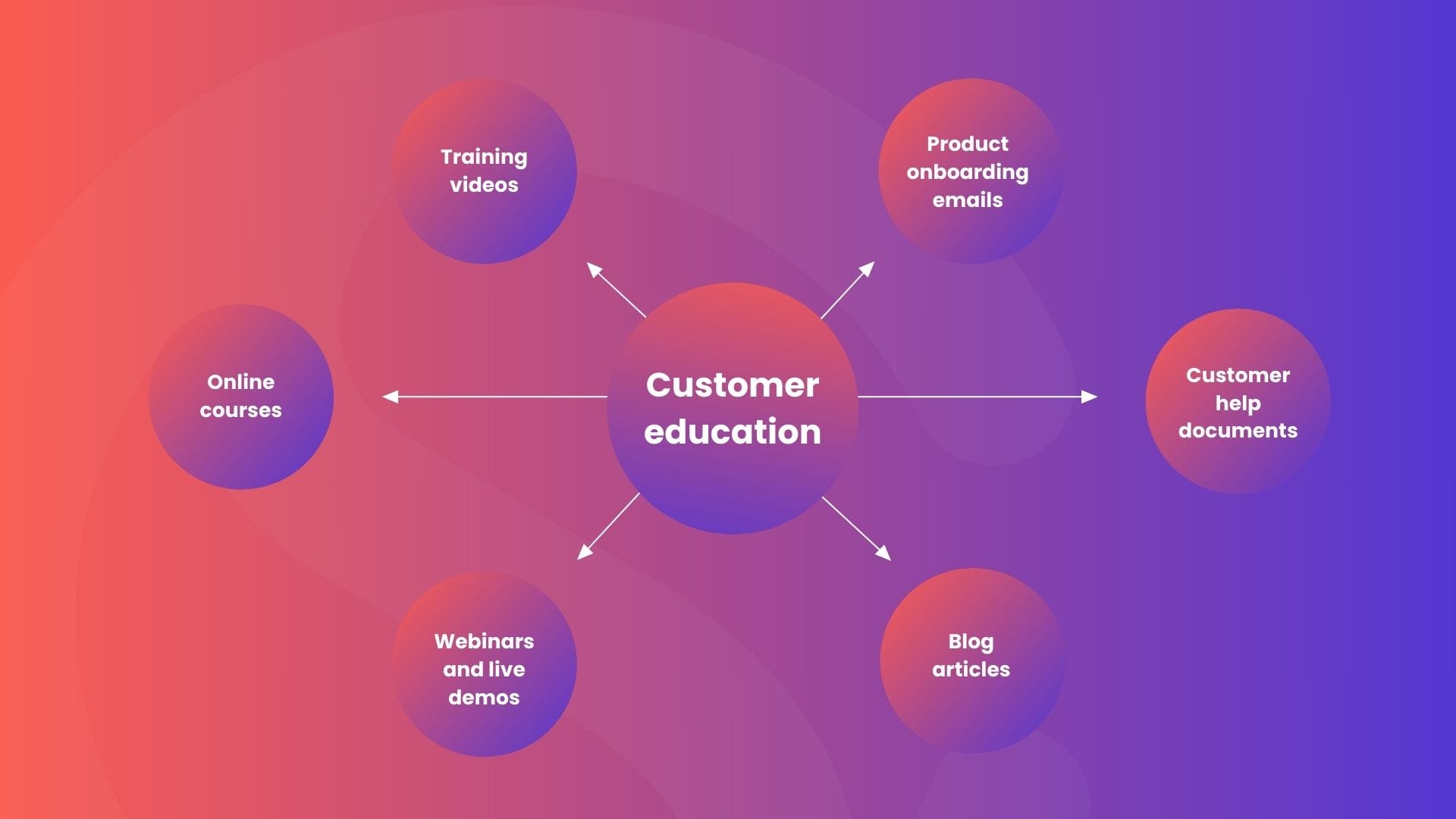It's wise to invest time and resources into developing a customer education program to ensure your customers are getting the absolute maximum value out of your product.
If your customers aren't continuously uncovering new ways to get value from your products or services, you're missing a vital opportunity to captivate them properly. And if they don’t know how to use your product, well, there’s only one thing for it: they’ve got to learn how to use it. The solution? Through customer education programs.
An eagerness to learn is like a seed that, over time, can blossom into deep engagement and brand loyalty. To capitalize on this desire to improve, you can look no further than with customer education.
Now, “customer education” as a principle sounds pretty didactic and conjures draconian images of school days gone by. We promise you that customer education couldn’t be further removed from that.
At the end of the day, customer education is about more than just imparting knowledge – it's about sparking curiosity and inspiration. But how to do this, you might ask?
In this article, we’re going to delve into:
- What customer education is
- Why customer education is so important
- What a customer education program is (and how to spot if you need one)
- Planning a customer education program
What is customer education?
Customer education plays a vital role in the customer success approach by equipping customers with the knowledge and skills needed to maximize the value they derive from a product or service.
It involves guiding new customers with tutorials and walkthroughs to effectively use your product. Comprehensive, digital educational resources are provided to deepen customers' understanding of features and troubleshooting methods.
Mediums of customer education are:
- Training videos
- Product onboarding emails
- Online courses or workshops
- Blog articles
- Webinars and live demos
- Customer help documents
Additionally, building user communities is a growth tactic to educate customers at scale, facilitating peer learning and support.
Continuously educating your customers keeps them informed about product updates, best practices, and industry insights. By empowering customers through education, frustrations are reduced, product utilization improves, and loyalty increases, positively impacting customer lifetime value.

Why is customer education important?
Research conducted by Forrester, commissioned by Intellum, reveals that an overwhelming majority, nine out of 10 companies, have experienced favorable financial returns from their investments in customer education initiatives. And it doesn't end there.
When given a lineup of four brands to purchase from, 83.6% of consumers chose the brand that provided them with educational content.
These cutting-edge programs go beyond merely supplying customers with valuable learning materials; they cultivate enduring engagement and foster a deep sense of loyalty. By moving away from outdated, manual training techniques and embracing interactive, self-guided digital platforms, companies can seamlessly align with the preferences of today's tech-savvy consumers.
This transition not only elevates the overall customer experience but also streamlines operational efficiencies, allowing teams to redirect their efforts from labor-intensive training tasks to more strategic endeavors.
Some people just put it better than others; here's what Northpass's Founder, Steve Cornwell, makes of customer education:
"If we, as leaders, begin to think about education not just during the initial onboarding but as a continuous process when new features are updated and new users get added to the platform, we can really start to see a change. This requires new infrastructure that facilitates a seamless learning experience, fully automated digital learning operations, and insights to ensure customer engagement."
Here are some key reasons why a customer education program is important for your business:
1. Increase product adoption and usage
If customers don't fully understand how to use your product's features and capabilities, they won't be able to realize its full potential value. A good customer education program teaches them how to properly use the product through training materials, guides, videos, etc.
2. Reduce customer support burden
Customers who lack knowledge about the product will inevitably have more questions and issues, resulting in higher support costs for your company. Education gives customers self-service resources to find answers themselves.
3. Improve customer satisfaction and retention
When customers can get more value from the product through education, they are more satisfied and more likely to remain loyal customers for longer. Lack of education often leads to frustration and churn.
4. Open up cross-sell/upsell opportunities
The more educated customers are on advanced features, the more opportunities arise to sell additional add-ons, upgrades or complementary products they can leverage.
5. Build product experts and advocates
Great education turns some customers into product experts and passionate advocates who can provide positive word-of-mouth marketing for your brand.

Planning your customer education program
To implement a successful customer education program, your business should follow a structured approach. Here are five things to consider when planning your digital customer education program.
1. Define the scope and central goal
Identify your target audience, analyze your product or service, consult stakeholders, and set a clear central goal.
Are you aiming to engage and/or educate your whole customer base or just certain segments? If it's just certain segments, then why? How will this help you achieve your business goals? Regularly revisit these elements to ensure alignment with business objectives and customer needs.
2. Examine the post-sales process and implementation
Take a careful look at problems your customers are running into post-sale. Map the customer journey, identify pain points, and assess skill gaps. This information will help you tailor your education content to address the specific challenges and knowledge gaps faced by your customers.
3. Segment your customer base via product fit
Evaluate customer size, industry, and experience to segment customers based on their unique needs. This will allow you to tailor education plans to meet the specific requirements of each segment. For example, a large enterprise customer with a dedicated IT team may require different educational resources compared to a small business or individual consumer.
4. Gather customer renewal feedback
It's a good idea to ask for feedback on engagement and education during contract renewals. Create a process to gather that feedback so you can use it to identify areas for improvement and refine your customer education plan. This feedback can be invaluable in understanding what resonates with your customers and what areas need further attention.
5. Prioritize your research
Once you've defined your goal, spoken to stakeholders, gathered customer research through analyzing the sales process and looking at renewal feedback, and segmented your customer base, you need to prioritize. Are there any areas that need urgent attention?
If a lack of education is stopping your customers from using a particular feature altogether, for example, that is something that needs to shoot straight to the top of your priorities.
Remember, in order to create a great engagement and education program, you don't need to start completely from scratch. Use the expertise and customer feedback you already have within your team to feed into this initiative.
If you work in a larger team, you could consider creating a sub-team that looks specifically at engagement and education. If you work alone, give this initiative its own time and space within your workload. As always, communicate to leadership that you're doing this work because it contributes to key metrics such as customer lifetime value, customer satisfaction scores, and churn rate.

To wrap up
You know you need a formalized customer education program when you see signals like high support costs, low product adoption metrics, negative feedback about lack of training, or churn from customers who never fully utilized the product's value. An ad-hoc approach won't cut it – you need a well-designed program.
But remember, a successful customer education program is an ongoing initiative that requires dedicated resources, cross-functional collaboration, and a commitment to continuous improvement. By investing in this effort, you can empower your customers, foster product mastery, and ultimately drive long-term success for both your customers and your business.



 Follow us on LinkedIn
Follow us on LinkedIn




